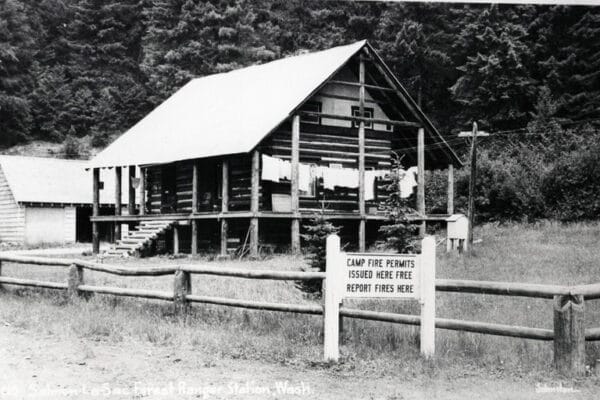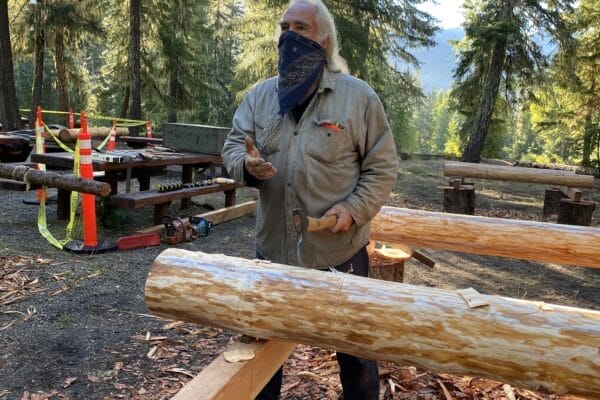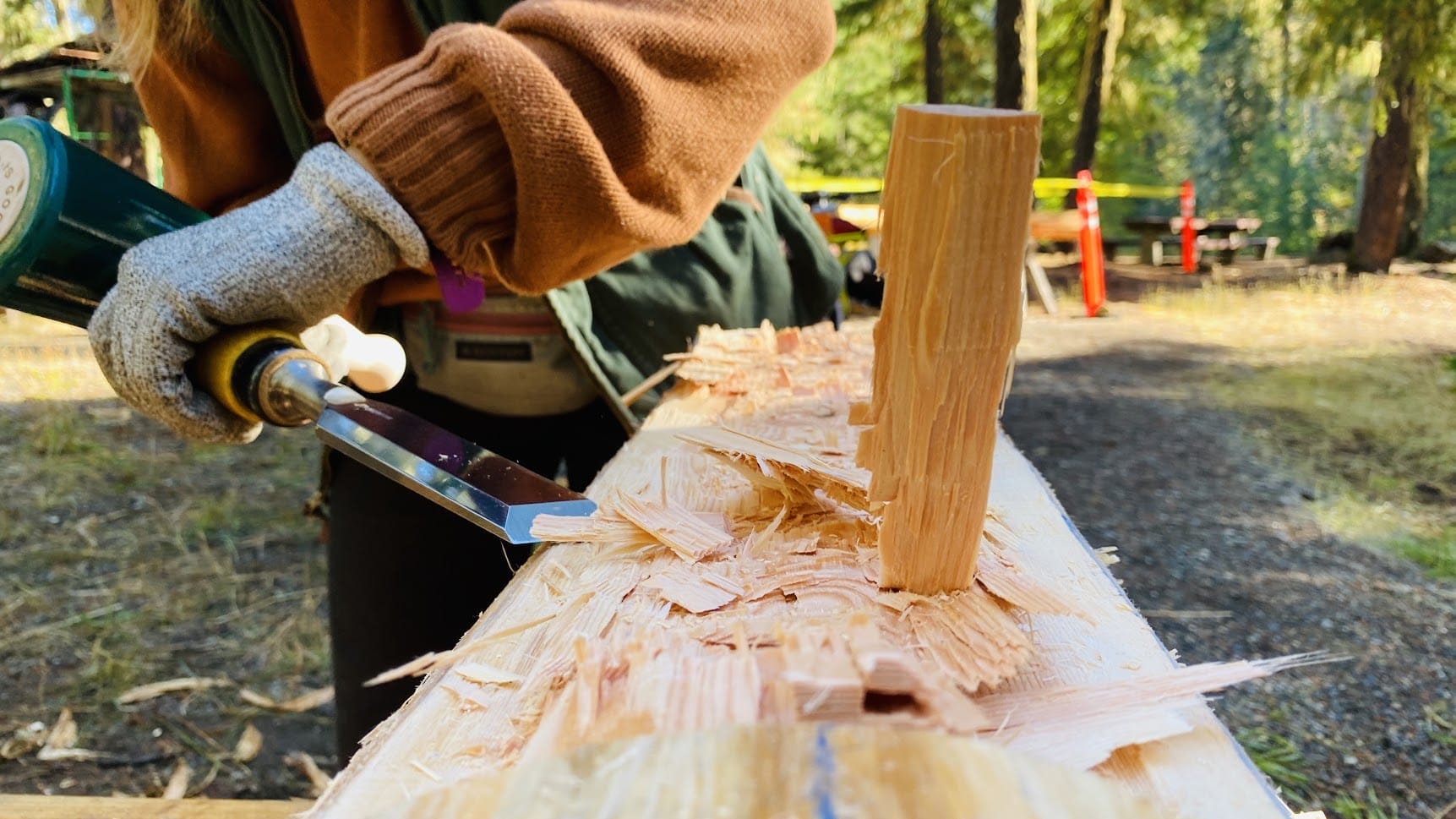Getting Hands On with History at the Salmon la Sac Picnic Shelter
During the last days of September, the Mountains to Sound Greenway Trust hosted a week-long volunteer event and traditional skills workshop at the Salmon la Sac picnic shelter, which was built by the Civilian Conservation Corps (CCC) in 1936. The goal of the volunteer event was to construct an informational kiosk using traditional log building techniques to match the style of the picnic shelter, nearby Salmon la Sac guard station, and other early-century log structures in the vicinity. This effort fits into a half-century-long history of preserving historic structures in Upper Kittitas County beginning at least as early as 1977, when the Salmon la Sac guard station was saved from destruction.
In 2016, 80 years after its construction, the US Forest Service (USFS) closed the shelter. Time and weather had compromised the structure’s stability, rendering it potentially dangerous to campers and picnickers. Generations of Kittitas County residents cooked meals in its stone oven, camped under its cedar-shake roof during poor weather, and sat cross-legged on its floor at movie nights hosted by Forest Rangers.

After four years of standing empty, encircled with yellow caution tape and do-not-enter signs, the USFS Cle Elum Ranger District and the Mountains to Sound Greenway Trust partnered to bring it back to life. The process began in 2018, with a grant from the Secure Rural Schools and Community Self-Determination committee. Even with the money securely in-hand, the Greenway Trust and USFS needed a builder who understood the traditional methods used by the Civilian Conservation Corps, who could replicate their style to the US Department of Interior’s Historic Preservation standards, and who understood how to source materials locally and implement them seamlessly into the existing structure.
Enter David Rogers, of the Cascadian Log School and his company, Logs & Timber, LLC. Not only is David a highly skilled craftsman trained in the art of log home building and design, he also has an extensive professional background in restoring and rehabilitating log structures on National Forest, National Park, state, and tribal lands. He is deeply committed to the preservation of these historic buildings and structures, so that they can remain in use and appreciation by the public. He’s also no stranger to Salmon la Sac. In 1995, the Cle Elum Ranger District contracted David to restore the SLS Guard Station, a log cabin that served USFS personnel as seasonal quarters from 1912 until 1964, when it too was deemed unsafe.

When buildings are determined ‘surplus’ to USFS needs, they’re most often left to fall apart, or preemptively torn down. Costs of repairs are so high, qualified craftspeople so few and far between, and the demands on the agency’s limited resources so numerous, that historic building restoration just isn’t a high priority. The Guard Station was saved by nomination to the National Register of Historic Places in 1977, but no such rescue seemed possible for the picnic shelter—in fact, a similar shelter was recently dismantled at Crystal Springs Campground. But the USFS and the Greenway Trust saw an opportunity to not only save an iconic local landmark, but to teach others the skills and tools of historic preservation! We didn’t just hire a contractor in David—we hired a teacher.

The Greenway Trust organized a five-day workshop coinciding with the picnic shelter repairs, where a small group of committed volunteers would build a kiosk from scratch, using the same techniques the CCC employed on the picnic shelter. With David as their patient leader, these volunteers were introduced to the principles and techniques of building with logs, from designing and laying out each unique log to the delicate art of shaping a notch by scribe, axe, and mallet and gouge. Each day, the group built upon their skills and with constant practice, the group’s understanding, attention to detail, and technique sharpened so much so that David could step back, observe, and offer deeper instruction as needed, a true testament to his leadership.
The kiosk, which will host information about the picnic shelter, the CCC, and campground rules, will be installed in Summer of 2021—the USFS plans to lay asphalt for ADA accessibility, which must be done before metal bracings and rockwork can be placed. Knowing that the kiosk would be moved and assembled at a later date, the volunteers did not put shakes on the roof during this workshop. Instead, they unanimously agreed to come back next year for a Phase II! They even intend to build the rockwork footings themselves, a task that had originally been assigned to Cle Elum Ranger District staff. Maybe we all got to feeling a little protective (and possessive) of what we’d built, much like the retired USFS staff who swung by to chat with David about their collaboration on the guard station back in the ’90s.

Meanwhile, the work on the picnic shelter itself continues. David and his crew have replaced and recycled the roof shakes, repaired the rafters, removed the deteriorated logs and refitted new ones in their places, and corrected a previous attempt at modifying the chimney, which did not comply with historic preservation standards. Their work is set to conclude mid-October.
The Salmon la Sac project overcame many hurdles to reach the finish line: lack of funds, rare technical knowledge, COVID-19, stifling wildfire smoke, and an ever-ticking clock against grant deadlines and wood-boring insects. We could not be happier or more excited for the work David, his crew, and the volunteers were able to accomplish, but we don’t plan to stop here. Across the Greenway, public lands are strewn with similar structures in states of disrepair and deterioration. As a newly designated National Heritage Area, the Greenway Trust has an obligation to shine a spotlight on their historical importance and cultural significance. Although we partnered with the USFS to install interpretive signage at the Guard Station in 1999, this project deepens our ties and commitment to the preservation of regional heritage.
To quote David:
“Historic structures are incredible witnesses of our nation’s past. Preserving them is our responsibility, and a respectful gesture to our collective history. They allow us to feel the presence of our ancestors, and better understand how they lived. They give us evidence and insight into the ingenuity and craftsmanship of the work accomplished with different tools, different means and different methods. They provide a connection to memories.”






